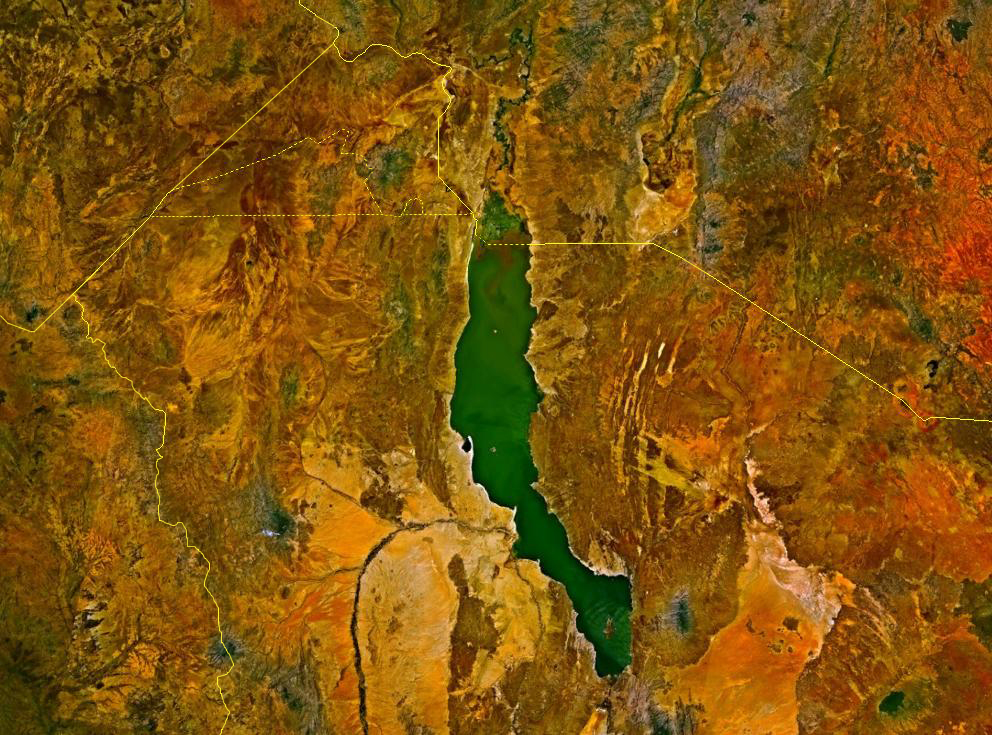http://en.wikipedia.org/wiki/Lake_Turkana wrote:
<<Lake Turkana, formerly known as Lake Rudolf, is a lake in the Great Rift Valley in Kenya, with its far northern end crossing into Ethiopia. It is the world's largest permanent desert lake and the world's largest alkaline lake. By volume it is the world's fourth largest salt lake after the Caspian Sea, Issyk-Kul Lake and the (shrinking) Aral Sea. The water is potable but not palatable. It supports a rich lacustrine wildlife. The climate is hot and very dry.
Three rivers (the Omo, Turkwel and Kerio) flow into the lake, but lacking outflow its only water loss is by evaporation. Due to temperature, aridity and geographic inaccessibility, the lake retains its wild character. The rocky shores are home to scorpions and carpet vipers.
The lake formerly contained Africa's largest population of Nile crocodiles: 14,000. The lake also has a large population of large water turtles particularly in the area of Central Island.
Terraces representing ancient shores are visible in the Turkana basin. The highest is 75 m above the surface of the lake (only approximate, as the lake level fluctuates), which was current about 9500 years ago, at the end of the Pleistocene. It is generally theorized that Turkana was part of the upper Nile system at that time, connecting to Lake Baringo at the southern end and the White Nile in the north, and that volcanic land adjustments severed the connection. Such a hypothesis explains the Nile species in the lake, such as the crocodiles and the Nile Perch.
The rocks of the surrounding area are predominantly volcanic. Central Island is an active volcano, emitting vapors. Outcrops and rocky shores are found on the East and South shores of the lake, while dunes, spits and flats are on the West and North, at a lower elevation.
On-shore and off-shore winds can be extremely strong as the lake warms and cools more slowly than the land. Sudden, violent storms are frequent. The Lake Turkana Wind Power consortium plans to provide 300 MW of clean power to Kenya's national electricity grid by tapping the unique wind conditions around the lake. The plan calls for 360 wind turbines, each with a capacity of 850 kilowatts. As of March 2010, the project had found financing, and the Kenyan government will take responsibility for the construction of the transmission lines. If completed, it will become the largest wind power project in Africa.
Around 2 million–3 million years ago, the lake was larger and the area more fertile, making it a centre for early hominins. Richard Leakey has led numerous anthropological digs in the area which have led to many important discoveries of hominin remains. The two-million-year-old Skull 1470 was found in 1972. It was originally thought to be Homo habilis, but the scientific name Homo rudolfensis derived from the old name of the Lake Rudolf, was proposed in 1986 by V. P. Alexeev. In 1984, the Turkana Boy, a nearly complete skeleton of a Homo erectus boy was discovered by Kamoya Kimeu. More recently, Meave Leakey discovered a 3,500,000-year-old skull there, named Kenyanthropus platyops, which means "The Flat-Faced Man of Kenya".
The lake was named Lake Rudolf (in honor of Crown Prince Rudolf of Austria) by Count Sámuel Teleki de Szék and his second-in-command Lieutenant Ludwig Ritter Von Höhnel, a Hungarian and an Austrian, 6 March 1888. They were the first Europeans to have recorded visiting the lake, "finding" it on a large safari across East Africa. At some unknown time the lake became known as the Jade Sea from its turquoise color seen on approaching from a distance. The color comes from algae that rise to the surface in calm weather. This is likely also a European name. The Turkana refer to the lake as anam Ka'alakol, meaning the sea of many fish.>>
